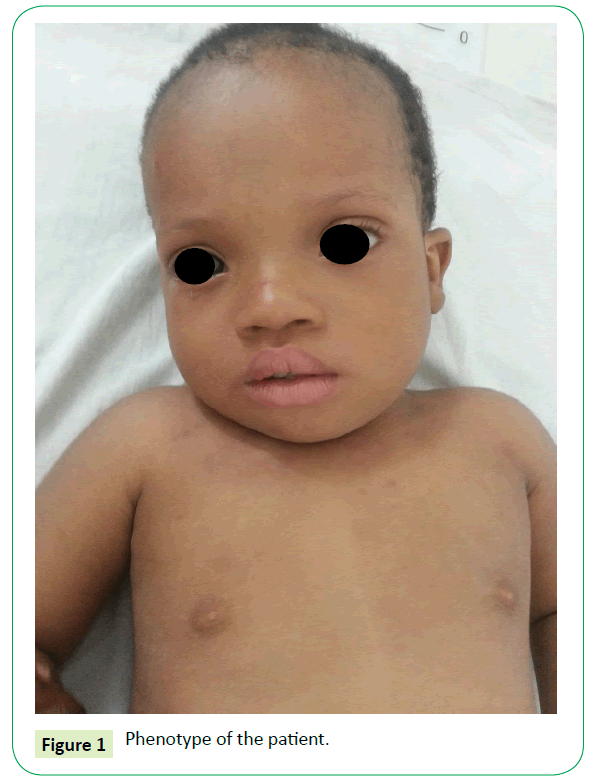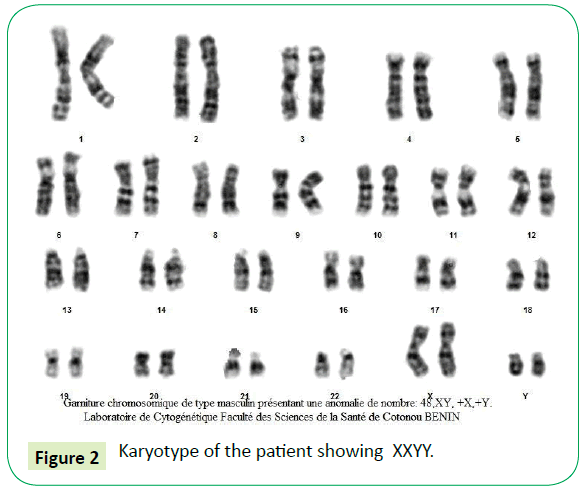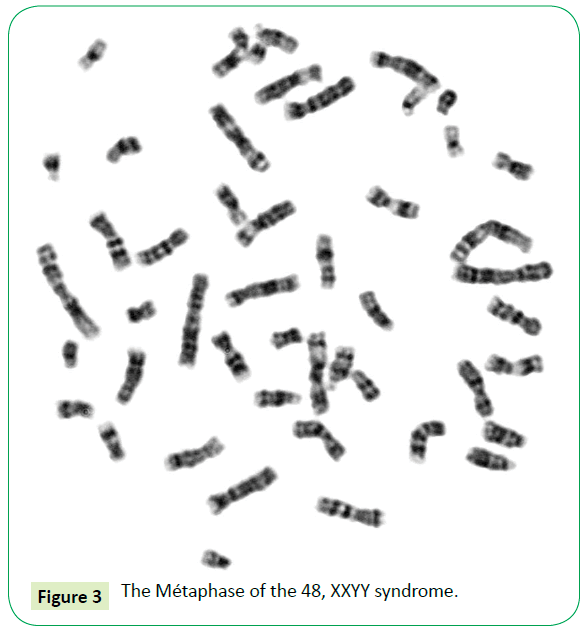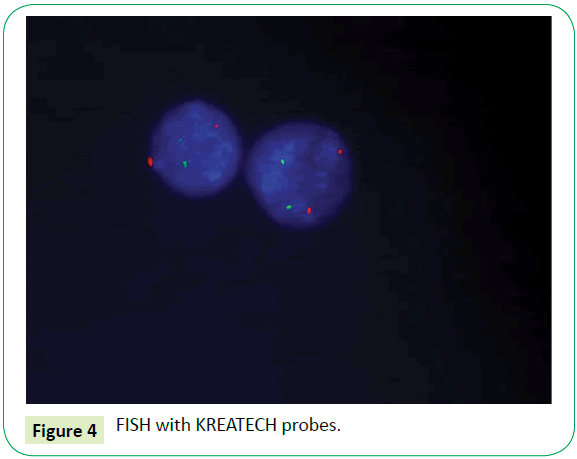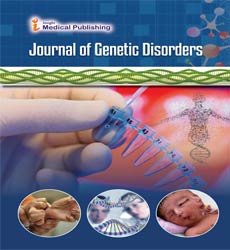The 48 XXYY Syndrome in a Beninese Child: Clinical Features and Genetic Considerations
Simon Azonbakin1*, Marius Adjagba1, Natacha Nbouke1, Diane Adovoekpe1, Arnaud Agbanlinsou1, Jules Maroufou Alao2, Flore Gangbo1 and Anatole Laleye1
1Service d’Histologie, Biologie de la Reproduction, Cytogénétique et Génétique Médicale, Faculté des Sciences de la Santé, Université d’Abomey-Calavi, Benin
2Service de Pédiatrie et de Génétique Médicale, Centre Hospitalier et Universitaire de la Mère et de l’Enfant (CHUMEL), Benin
- *Corresponding Author:
- Simon Azonbakin
Service d’Histologie
Biologie de la Reproduction
Cytogénétique et Génétique Médicale
Faculté des Sciences de la Santé
Université d’Abomey-Calavi, Benin
Tel: +0022997130061
E-mail: azandeg@yahoo.fr
Received Date: July 11, 2018; Accepted Date: August 16, 2018; Published Date: August 23, 2018
Citation: Azonbakin S, Adjagba M, Nbouke N, Adovoekpe D, Agbanlinsou A, et al. (2018) The 48 XXYY S yndrome in a Beninese Child: Clinical Features and Genetic Considerations. J Genet Disord. 2:6.
Abstract
The 48 XXYY syndrome is a distinct clinical and genetic entity with an incidence of 1/40000 to 1/18000. A 15-month-old child was admitted in genetic clinics for psycho-motor delayed management. The patient disclosed a dysmorphism with hypertelorism, up slanting palpebral fissure, broad, high and bulging forehead, hypertelorism, very marked furrow of the filtrum and the mouth in the shape of a cocked hat, a microstomy and a development delay. The Karyotype study showed a 48, XXYY chromosome which was present in all analyzed cells. Here, we report a case of a patient with 48, XXYY syndrome diagnosed at the age of 15 months old in order to show the particularities of this syndrome in a beninese child.
Keywords
48 XXYY syndrome; Development delay; Dysmorphism
Introduction
The 48, XXYY syndrome is a dysgonosomy (sex chromosome aneuploidy (SCA)) that was first reported in 1965 [1]. The 48, XXYY syndrome is estimated to occur in 1/40000 - 1/18000 male births [2]. The 48, XXYY syndrome is often compared with the 47, XXYY known as Klinefelter syndrome because key futures are shared by both including tall stature and hypergonadotropic hypogonadism [3]. Most of SCA have a variable phenotype that includes dysmorphism and attention-deficit hyperactivity disorder (ADHD) symptoms [4,5]. Here we report the first case of 48 XXYY syndrome in the beninese child. We describe it through a phenotype description and extension on genetic considerations.
Case Report
A 15-month-old child was admitted in the medical genetic ward for psycho-motor delayed management at the service of pediatrics and medical genetics of the teaching hospital “ Mère et de Enfant” Cotonou- Benin Republic. The patient was born at the end of a normal pregnancy. The APGAR was 9/10/10. The unrelated father and mother are aged 38 and 30, respectively. The patient’s psychomotor development was characterized by a sitting position around 6 months, a walk with 4 atypical feet (dragged by the buttocks) and the language was not acquired. The physical examination showed a psycho-motor retardation, and a dysmorphism with hypertelorism, up slanting palpebral fissure, broad, high and bulging forehead, hypertelorism, very marked furrow of the filtrum and the mouth in the shape of a cocked hat, a microstomy. Also noted are anterior nostrils, ears loosened and poorly hemmed, and a flat nape (Figure 1). A patent ductus arteriosus was seen during the heart ultrasonography. After obtaining an informed consent of the parents, the peripheral blood was collected and processed by standard techniques for conventional cytogenetics. The karyotype performed according to the G-band techniques showed abnormality of the sexual chromosomes (48 XXYY) (Figures 2 and 3). This abnormality was confirmed at FISH with the Kreatech® probes (Figure 4). The karyotype of both parents was normal.
Figure 1: Phenotype of the patient.
Discussion
Sex chromosome abnormalities are diseases resulting from the absence or excess of all or part of a sex chromosome (X or Y). The 48, XXYY Syndromes is an uncommon sex chromosome aneuploidy condition that is characterized by the presence of one extra X and Y chromosomes in males. Until earlier in the 2000’S, the XXYY Syndrome was considered as a variant of the Klinefelter syndrome (which includes the karyotypes 47, XXY; 48, XXYY; 48, XXXY and 49 XXXXY) [1,4]. For some authors, the 48 XXYY represents about 2.3% of all cases of Klinefelter Syndrome [1], while some suggested to consider it as a distinctive syndrome [1,5]. The age for diagnosis often varies in relation to the severity of the presentation. In the case of our patient, dysmorphism was characterized by hypertelorism, oblique palpebral slits at the top and the outside, anterior nostrils, ears loosened and poorly hemmed, a microstomy and a flat nape. Early diagnosis at the age of 15 months (before 2 years) represented 30 percent of the reported cases [4]. This is probably related to the variety of the clinical signs especially the psycho-motor retardation. Mental retardation was reported to be a constant feature in the 48 XXYY syndrome varying from more or less normal to severe. It is attributed mainly to the polysomy, and probably to a skewed X inactivation [6]. Neurological problems associated with the XXYY syndrome include increased rates of seizures, intention tremor, and tics [7,8]. These neurological signs, especially the tremor, appear with age and therefore need to be monitored in our patient. A significant proportion of patients with 48 XXYY have an intellectual disability, with 26 percent having a IQ below 70 among them presenting a significant impacted adaptive functioning [4]. They can have impulsive and aggressive features and very low tolerance to frustration. Other associated medical problems include increased rates of congenital heart malformation, asthma and respiratory infections, hypothyroidism, sleep apnea, type II diabetes, radioulnar synostosis, deep venous thrombosis and renal hypouricaemia [4,5,9,10]. In our case the congenital heart malformation was patent ductus arteriosus. In the XXYY syndrome, there is a microorchidism with hyogonadism related to a deficit of testosterone secretion [9,11]. This deficiency in testosterone will lead to a delay in puberty. This risk could be prevented by a treatment with hormonal supplementation (Testosterone) at the beginning of the adolescence. Testosterone also has beneficial long-term effects that might reduce the risk of osteoporosis, auto-immune disease, and breast cancer. Testosterone replacement also results in general improvement in behavior and work performance [1,4,12]. Beyond all, the prognosis remains bad in term of fertility since this child will remain barren all his life. It is therefore important that genetic counseling focusses on this aspect early enough in order to better prepare the child's family. In adulthood, the large size in connection with an over-expression of the SHOX gene will be a constant sign [13]. Most XXYY syndrome results from an accident of fertilization with parental gametes which are completely normal and which cause meiotic non-disjunction I or II in normal parents produce an abnormal egg XXYY. This is probably the case in our child as the karyotype of his parents are normal. An infrequent origin of the 48, XXYY syndrome was coming from a somatic abnormality in the father XYY with gametes 24, X and 24, Y [14]. This situation leads to a very high risk of recurrence. The recurrence risk is not higher than in the general population. There is no evidence to suggest that a chromosomal non-disjunction process is likely to repeat itself in this particular family. Genetic counseling could be done with assurance of little risk recurrence in the future but fetal karyotyping and well organized ultrasound monitoring could be of a great help in reducing recurrence. In the case of a foetus, with molecular genetics confirmation, the possibility should be given to the parents to carry out a therapeutic abortion.
Conclusion
48 XXYY is a rare SCA unknown in our country. The most common indication for genetic testing in males found to have XXYY is a history of developmental delays, learning/cognitive deficits, and/or behavioral difficulties. It’s a rare dysgonosomy resulting most often during fertilization accidents. The diagnosis was made in our child on the basis of a dysmorphic syndrome and psychomotor retardation.
Conflict of Interest
The authors declare that there is no conflict of interests regarding the publication of this paper.
References
- Muldal S, Ockey CH (1960) The “double male”: a new chromosome constitution in Klinefelters syndrome. Lancet 276: 492-493.
- Cordeiro L, Tartaglia N (2013) XXYY Syndrome. Brenner’s Encyclopedia of Genetics, 2nd edition, pp: 369-371.
- Tartaglia N, Ayari N, Howell S, Epagnier CD, Zeitler P, et al. (2011) 48,XXYY, 48,XXXY and 49,XXXXY syndromes: not just variants of Klinefelter syndrome. Acta Paediatr 100: 851-860.
- Tartaglia N, Davis S, Hench A, Nimishakavi S, Beauregard R, et al. (2008) A New Look at XXYY Syndrome: Medical and Psychological Features. Am J Med Genet 146A: 1509-1522.
- Borghgraef M, Fryns JP, Van den Berghe H (1991) “The 48, XXYY syndrome. Follow-up data on clinical characteristics and psychological findings in 4 patients”. Genet Couns 2: 103-108.
- Iitsuka Y, Bock A, Nguyen DD, Samango-Sprouse CA, Simpsoneyer JL, et al. (2001) “Evidence of skewed X-chromosome inactivation in 47,XXY and 48,XXYY Klinefelter patients”. Am J Med Genet 98: 25-31.
- Zelante L, Piemontese MR, Francioli G, Calvano S (2003) Two 48, XXYY patients: Clinical, cytogenetic and molecular aspects. Ann Genet 46: 479-481.
- Jankovic J, Madisetty J, Vuong K (2004) Essential tremor among children. Pediatrics 114: 1203-1205.
- Zantour B, Sfar MH, Younes S, Alaya W, Kamoun M, et al. (2010) 48XXYY Syndrome in an Adult with Type 2 Diabetes Mellitus, Unilateral Renal Aplasia, and Pigmentary Retinitis. Case Rep Med 5: 479-481.
- Nakajima H, Tajima K, Nakajima T, Jida S, Sumi S, et al. (1986) Renal hypouricaemia in a patient with 48, XXYY syndrome. Postgrad Med J 62: 219-222.
- Vigi V, Pinca A, Guerrini P, Scappaticci S, Volpato S. et al. (1978) Endocrine function and diagnostic probrems in a prepubertal cases of XXYY. J Genet Hum 26: 411-417.
- Izumi S, Tsubahara A (2000) Improvement of peripheral neuropathy by testosterone in a patient with 48,XXYY syndrome. Tokai J Exp Clin Med 25: 39-44.
- Katsushima Y, Katsushima F, Katsushima N (2008) Extreme Tall Stature in a Japanese Boy with a 48,XXYY Karyotype. Clin Pediatr Endocrinol 17: 27-30.
- Balsera AM, EstévezMN, Beltrán, EB, Sánchez-Giralt P, García, LG, et al. (2013) Distinct mechanism of formation of the 48, XXYY karyotype. Mol Cytogenet 6: 25.
Open Access Journals
- Aquaculture & Veterinary Science
- Chemistry & Chemical Sciences
- Clinical Sciences
- Engineering
- General Science
- Genetics & Molecular Biology
- Health Care & Nursing
- Immunology & Microbiology
- Materials Science
- Mathematics & Physics
- Medical Sciences
- Neurology & Psychiatry
- Oncology & Cancer Science
- Pharmaceutical Sciences
